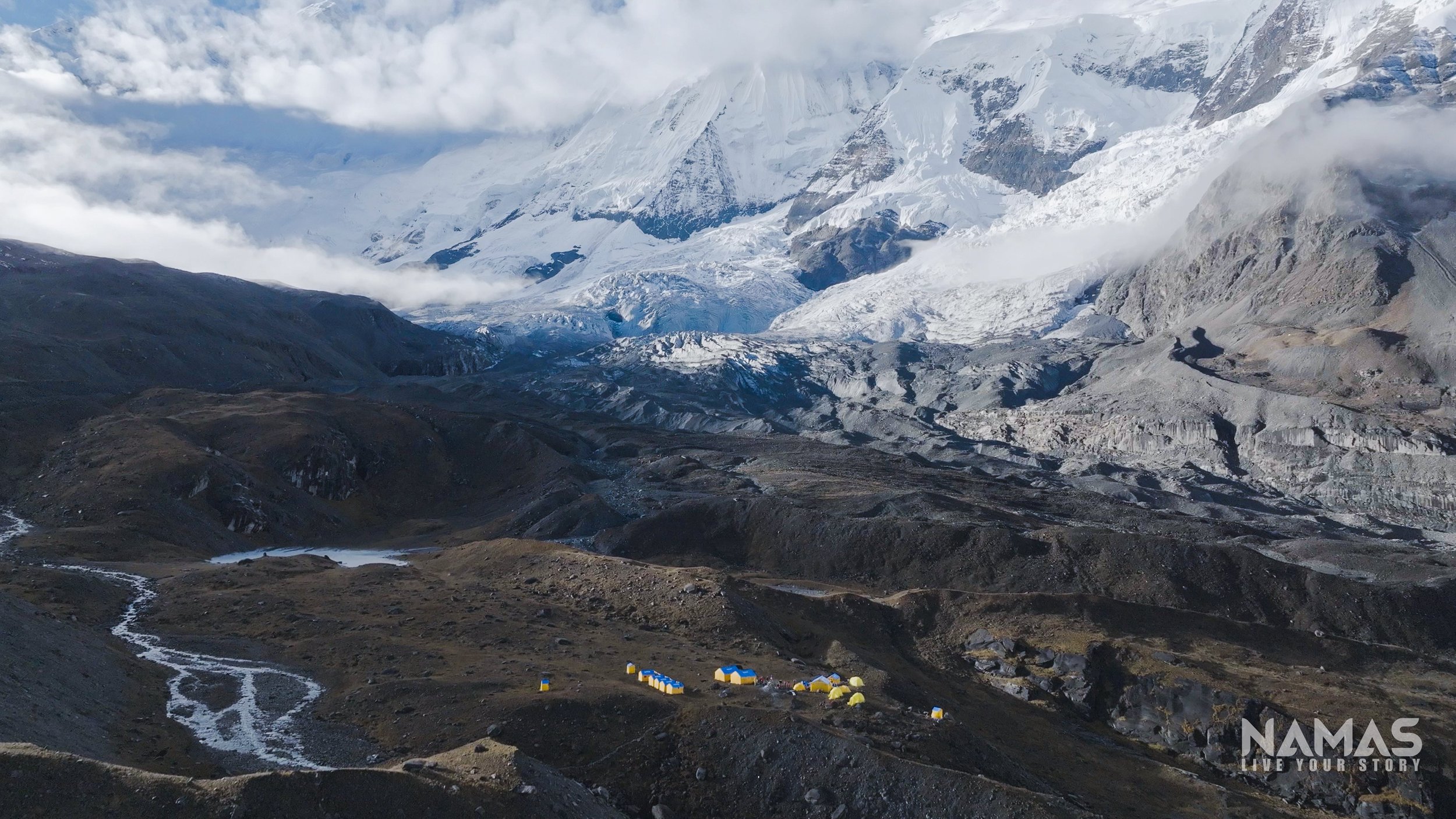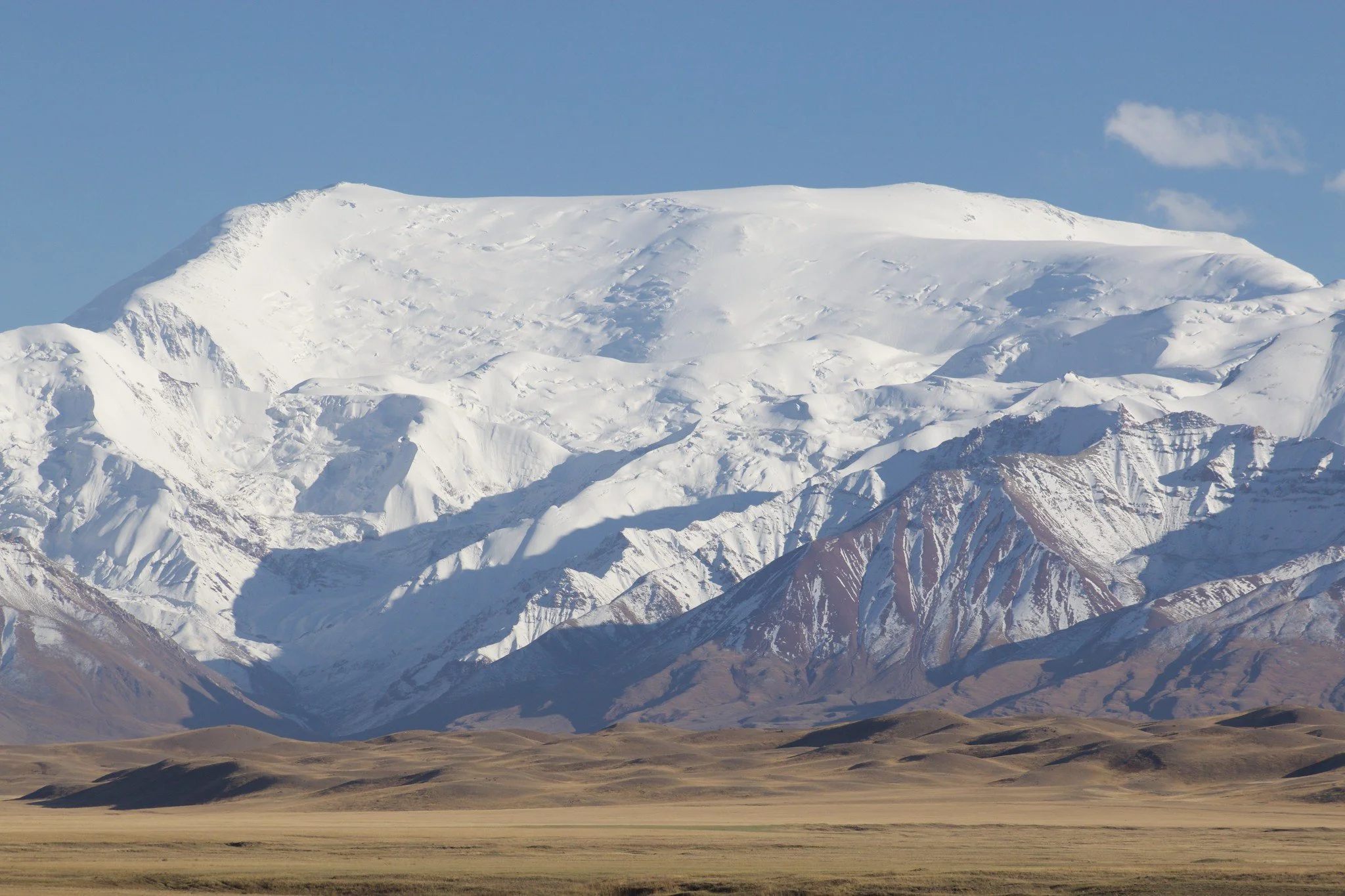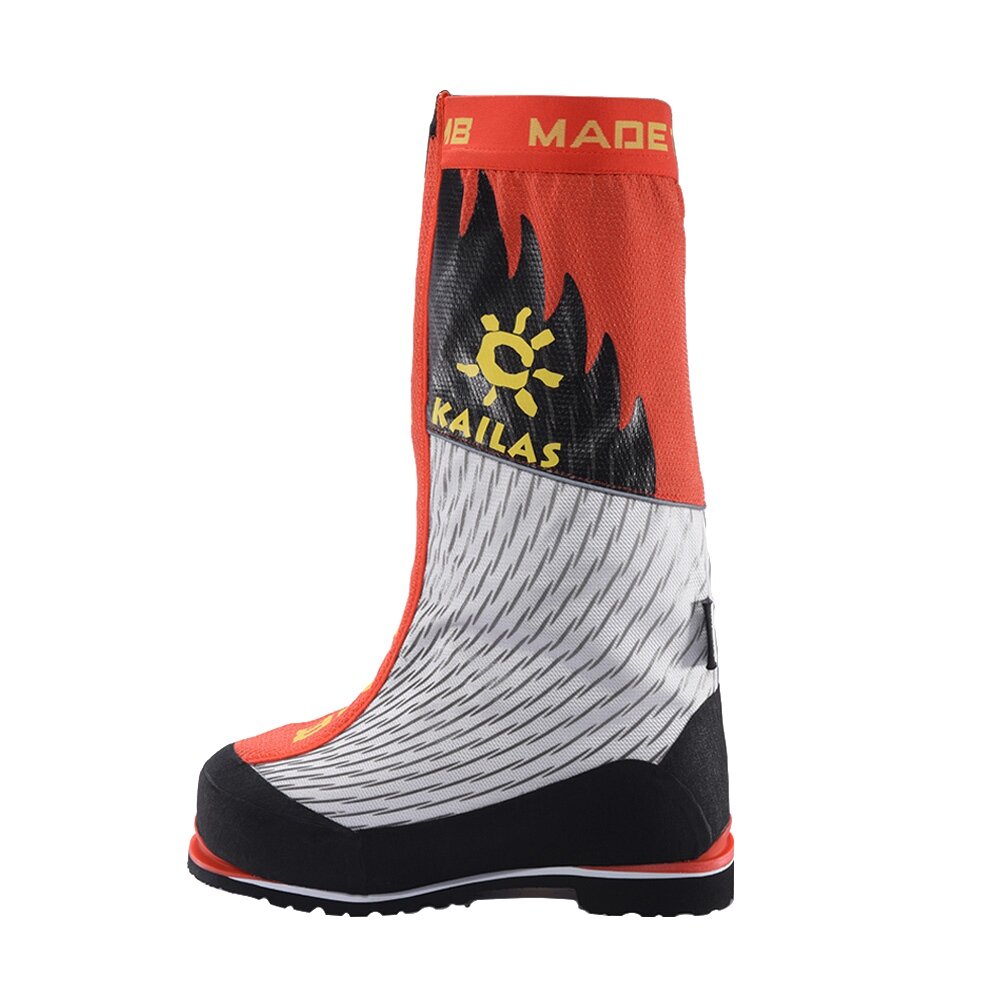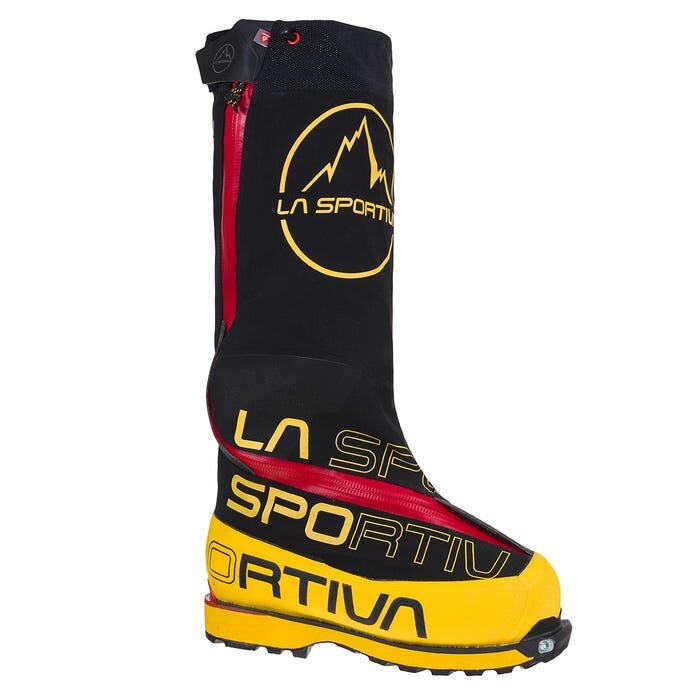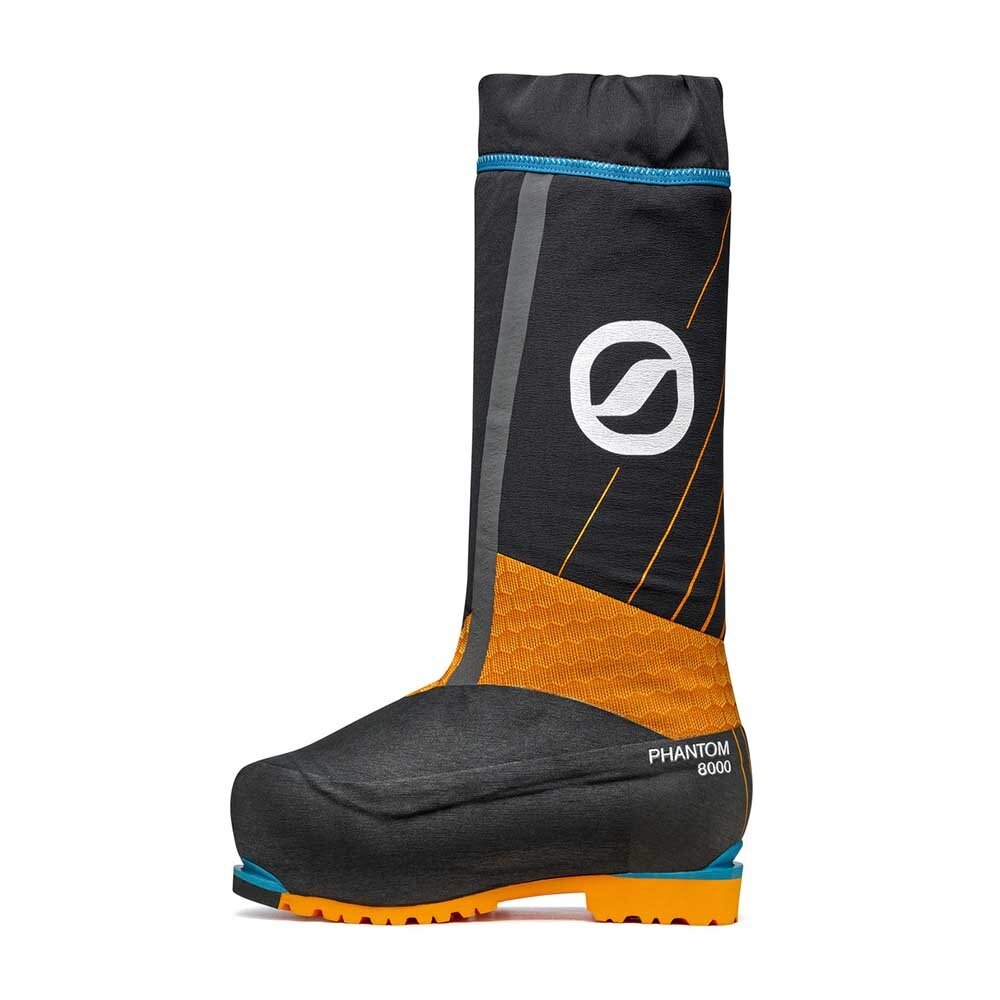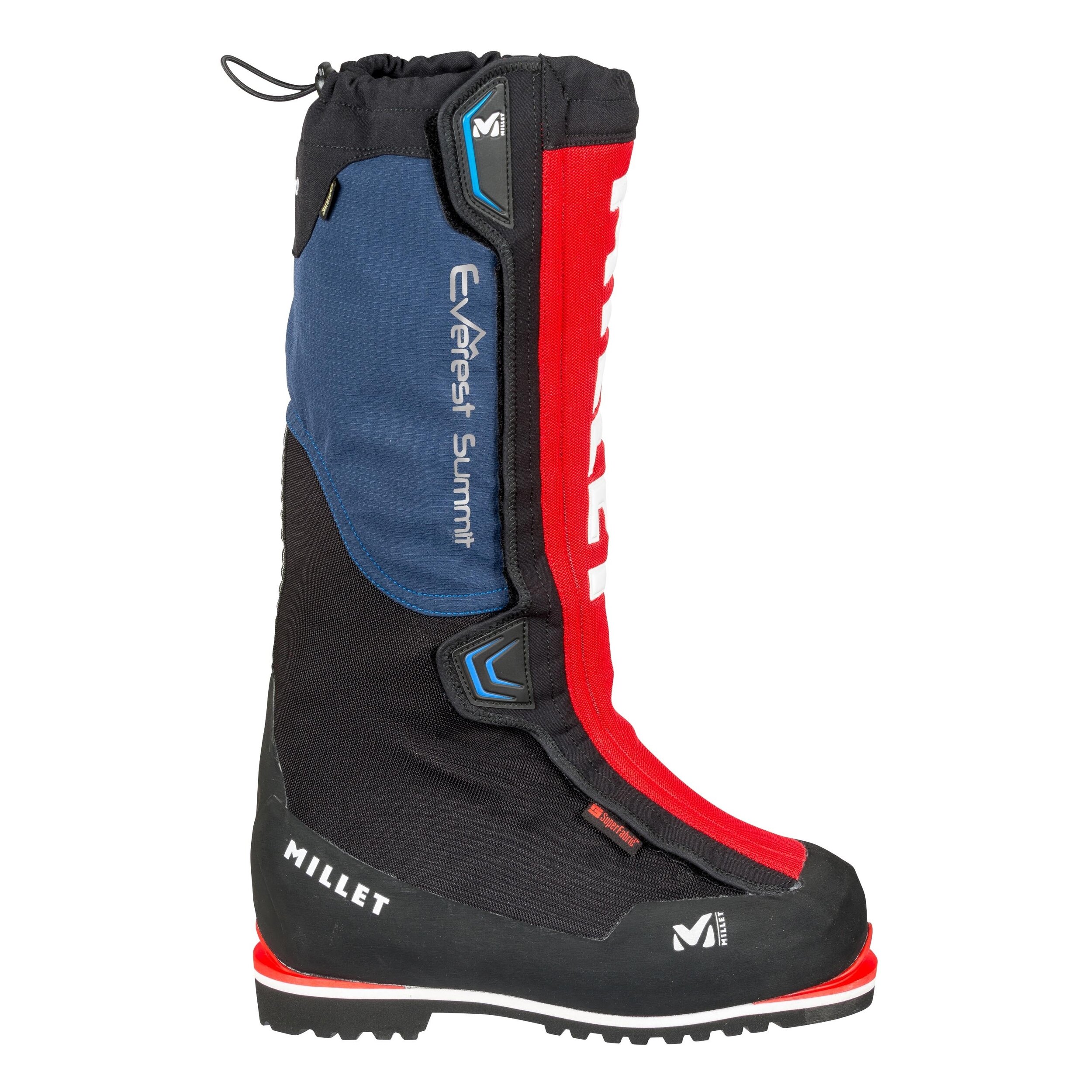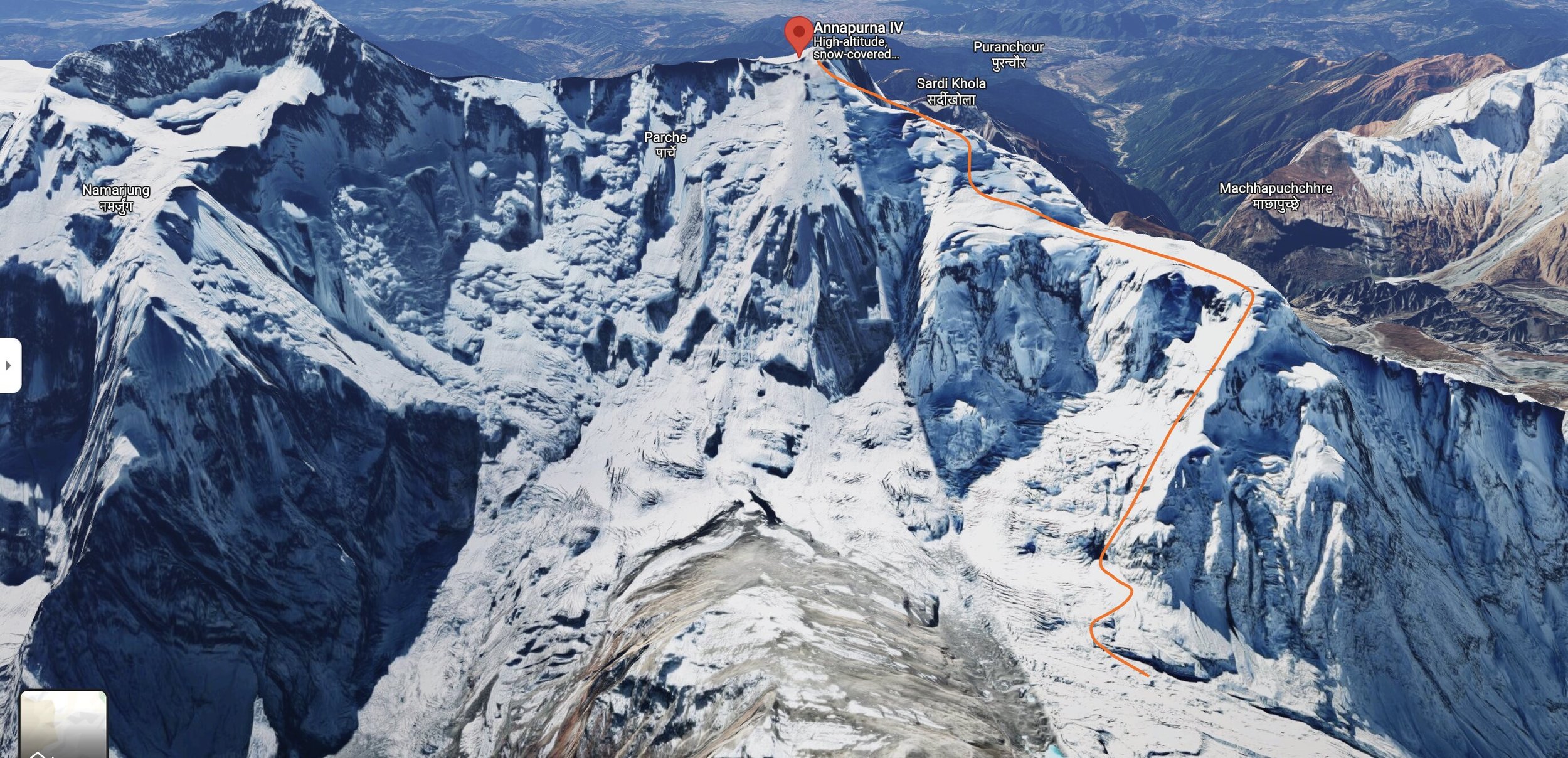Comparing 7000M Peaks: Which One is Right for Your Next Expedition?
Annapurna IV 7525M summit seen in the middle with Annapurna 2 on the left.
Perhaps you have completed several 4,000m to 6,000m summit expeditions and are now seeking a greater challenge. You might be exploring 7,000m mountains to enhance your high-altitude mountaineering experience, with aspirations of climbing Everest or one of the other 8,000m peaks. Alternatively, you may simply wish to immerse yourself in the pure exploration and remoteness that these high-altitude adventures offer.
Unsure on which 7000M peak to choose? In this blog post, we compare five prominent 7,000m mountain expeditions—Annapurna IV 7525M, Baruntse 7129M, Tilicho Peak 7134M, Himlung Himal 7126M, and Lenin Peak 7134M—to help you make an informed decision for your high-altitude journey.
1. Annapurna IV (7,525m)
Location: Annapurna Range, Nepal
Level: Advanced level
Technical Difficulty: High
Best Time to Climb: Spring (April-May) and Autumn (September-October)
Duration: 30 days
Key Features: Annapurna IV is a remote and lesser-climbed peak in the Annapurna range, known for its technical challenges. Climbers must have advanced skills in rock and ice climbing, as the route includes steep sections, exposed ridges, and deep snow. The peak's isolation offers a more immersive and adventurous experience, but it also demands excellent logistical planning. With only about 150 people ever reaching the summit, Annapurna IV is ideal for seasoned mountaineers seeking a quieter climb.
P.s. - Annapurna IV can be your expedition to prepare for Everest, Annapurna 1 or K2 expeditions.
Pros: Quieter, remote, and ideal as preparation for Everest or technical 8000m peaks.
Cons: Avalanche risk, technical sections, and steep terrain make it unsuitable for beginners.
2. Baruntse (7,129m)
Location: Barun Region, Nepal
Level: Intermedaite level
Technical Difficulty: Moderate to High
Best Time to Climb: Autumn (October-November)
Duration: 24 days
Key Features: Baruntse sits between the Everest and Makalu ranges, offering breathtaking views of both. It is popular among climbers preparing for lower 8000m peaks like Manaslu 8163M or Cho Oyu 8201M. The ascent becomes more technical after 6900m, particularly along the exposed summit ridge, which requires climbers to stay focused under challenging conditions. It’s a solid test for intermediate climbers who are ready for more demanding expeditions.
Pros: A great option for climbers seeking a moderate technical challenge before moving to 8000m peaks.
Cons: Exposed summit ridge demands advanced skills and leaves little room for error.
3. Tilicho Peak (7,134m)
Location: Annapurna Range, Nepal
Level: Intermedaite level
Technical Difficulty: High
Best Time to Climb: Spring (April-May) and Autumn (October-November)
Duration: 25-30 days
Key Features: Tilicho Peak offers a dramatic climb above Tilicho Lake, the highest lake in the world at 4900m. Though less famous than other Annapurna peaks, Tilicho is a technically demanding climb with steep rock scrambling, snow, and ice conditions at higher altitudes. This peak is for experienced climbers who have strong mountaineering skills and the endurance to navigate long, steep sections. Due to its remoteness, logistical planning is crucial, and only experienced teams should attempt this climb.
Pros: Stunning, remote, and less crowded with incredible views.
Cons: Requires advanced technical skills and careful planning due to the isolation.
4. Himlung Himal (7,126m)
Location: Manaslu Region, Nepal
Level: Entry level
Technical Difficulty: Moderate
Best Time to Climb: Autumn (September-October)
Duration: 25-30 days
Key Features: Himlung Himal offers a more moderate challenge, making it an excellent choice for climbers looking for an introduction to 7000m expeditions. The route to the summit is non-technical, consisting mainly of steady snow slopes and moderate crevasses. It’s a great option for those with limited experience who want to test themselves at high altitudes without the intense technical demands of other peaks.
Pros: Suitable for less experienced climbers with a straightforward route.
Cons: May not appeal to those seeking a more rugged, technical challenge.
5. Lenin Peak (7,134m)
Location: Pamirs, Kyrgyzstan/Tajikistan
Level: Entry level
Technical Difficulty: Moderate
Best Time to Climb: Summer (July-August)
Duration: 21-24 days
Key Features: Lenin Peak is one of the most accessible 7000m peaks, attracting many first-time high-altitude climbers. Its long, glaciated slopes offer a relatively straightforward ascent with minimal technical sections, but the altitude is still a serious challenge. Climbers must be well-acclimatized to avoid altitude sickness, and the unpredictable weather—particularly strong winds—adds another layer of difficulty.
Pros: Ideal for beginners seeking a high-altitude challenge without intense technical demands.
Cons: Crowded during peak season, with risks associated with altitude and harsh weather.
Comparison Summary
Which Peak is Right for You?
For Advanced Climbers: If you're looking for a highly technical challenge, Annapurna IV and Tilicho Peak are your best options. These peaks offer steep routes with plenty of rock and ice climbing, perfect for climbers with significant experience and no interest in crowded routes.
For Intermediate Climbers: Baruntse provides a good balance between moderate and challenging sections, making it a solid choice for those with some technical skills who are preparing for lower 8000m peaks.
For Beginners: Himlung Himal and Lenin Peak are great for climbers who are new to 7000m expeditions and want to experience the challenge of high-altitude mountaineering without the intense technical difficulties of other peaks.
Choosing the right peak depends on your experience, skill level, and what you want to achieve. Whether you’re aiming for a quiet, immersive climb on Annapurna IV or looking for an accessible, non-technical adventure on Lenin Peak, there’s a 7000m peak out there for you.
For more details on these expeditions and to plan your next adventure, visit our 7000M expedition page.
NAMAS Adventure
Everything you need to know about Cho Oyu 8201M Expedition - Namas Adventure
Climbing Cho Oyu (8201m), the world's 6th highest peak, is an incredible opportunity to stand atop one of the “easier” 8000m giants. Located on the Nepal-Tibet border, Cho Oyu offers stunning Himalayan scenery and a chance to glimpse life in Tibet. This complete guide provides everything you need to know to prepare for and succeed on the mighty Cho Oyu.
1. When is the best time to climb Cho Oyu?
The autumn months of September-October are an ideal season for climbing Cho Oyu.
2. How much does the Cho Oyu expedition cost? What does it include? How is Namas operating the expedition differently?
Our Cho Oyu expedition is priced at USD $33,000 per person and includes premium, high-quality all-inclusive peak climbing services. We prioritize safety by implementing a 1:1 guide-to-client ratio with additional Sherpa guides for high-altitude logistics/ rescue missions and the use of 4 X personal supplemental oxygen (highest in the industry). Our team is dedicated to ensuring your safety and making sure your expedition runs smoothly. As a company, we are committed to our core values of responsibility, ethics, and sustainability. With our team, climbers can focus solely on their climbing holiday and the fun times ahead without any worries.
List of what’s included in your booking.
IFMGA/NMA certified Guide leader
$1000 Individual tip pool. (This is not a summit bonus tip) The tip pool will be fairly distributed among all Namas staff members. (Guides, porters, drivers, hotel security, and staff). Guest may personally hand in extra tips to our guides and porters)
Namas Branded merchandise (Down Jacket, Cap, Buff)
1:1 Sherpa/client ratio. Additional Supporting Guides will be allocated based on climbing members’ number.
Head chef and kitchen helpers (Helpers increase with the number in climbing team members)
2 nights before the expedition and 1 day after the expedition. Hotel in Kathmandu. (Should clients return early from their expedition, clients will be responsible for their extra Kathmandu hotel bookings)
All trekking and climbing permits (Chinese government climbing permits)
All internal-local transportation to and from the trekking trail head. Tibet and Kathmandu
Flights Lhasha - Kathmandu - Lhasha
Expedition tents, single tents in Base Camps and shared in higher camps Brands Salewa, Mountain Hardwear, Samaya equipment, Kailas
4 Oxygen Bottles
60 kgs personal weight
Freezed dried meals during camping days (Chicken, mushroom, vegan options etc)
Chocolate, energy bars, hydration pills, biscuits, canned foods, nuts
Burners and expedition equipment
Walkie-talkie/ Satellite phone
Breakfast, Lunch, and Dinner on trek and expedition days.
Lodge accommodation during the trek
Porters per guest
Arrival pick up and departure
Basic First aid kit
Welcome/Farewell leave Dinner
4. The first ascent of Cho Oyu 8201M?
Cho Oyu was first summited in 1954 by a small Austrian/Tibetan expedition.
5. How many climbing routes are there to climb Cho Oyu?
There are two main commercial expedition routes in Cho Oyu. The west ridge route is the choice for most expedition companies.
6. Why is Cho Oyu considered easy and safest 8000M expedition?
Cho Oyu stands out as one of the easier and safer 8000m peaks, mainly attributed to its manageable technical difficulty and a camping/climbing route that is less susceptible to avalanches. The post-monsoon period in this region of Tibet-Nepal offers relatively stable weather conditions, resulting in a historically lower fatality rate compared to other peaks above 8000m. The presence of skilled Sherpa guides and the Nepalese climbing system further enhance the safety measures associated with Cho Oyu for high-altitude expeditions.
7. What level of experience and qualifications are required for climbers to safely participate in the Cho Oyu 8201M expedition? Additionally, is it necessary for climbers to be accompanied by professional guides?
Experiences - To participate in the Cho Oyu expedition, a minimum requirement is previous high-altitude climbing experience, including at least two 6000-meter peaks and one 7000-meter peak, such as Himlung Himal, Baruntse, Mt. Nun, or Spantik. It is a must for climbers to have knowledge and experience of long-duration hiking (10+ hours) and climbing using crampons on snow, ice, and steep surfaces, as well as being comfortable and proficient in using fixed ropes on steep and exposed sections. Additionally, it is important for climbers to have a good understanding of climbing gear, basic rope techniques, and the ability to handle cold and windy conditions. Unlike other places, rules in Tibets are strict and clients will have to present proof of certification for the pre-requirements before climbing 8000M peaks.
For those with intermediate experience levels and no previous 7000M+ climbing experience, we highly recommend gaining more experience before attempting this peak. However, for those with deep knowledge of climbing technical peaks and are seasonal alpine climbers, Cho Oyu may be considered. In Tibet, it is essential to experience the local way of doing things, and cultural perspective, bonding with local climbing leaders, and understand their perspective on climbing big mountains. This will give you a wider understanding of the climbing culture in Nepal.
8. What is the number of high camps established for the Cho Oyu expedition?
We will strategically plan 3-4 high camps during our Cho Oyu expedition mission.
Route: West Ridge, Tibet
Advanced Base Camp (5800M/18372FT)
Cho Oyu Camp 1 (6500M/21,325FT)
Cho Oyu Camp 2 (7100M/3,294FT)
Cho Oyu Camp 3 (7400M/24278FT)
Cho Oyu Summit (8201M/27765FT) 12 - 16hrs
9. What is the recommended itinerary for proper acclimatization during the Cho Oyu expedition?
As with all high-altitude expeditions, the principle of "climb high, sleep low" applies. Progressing slowly and steadily is key when climbing extreme high-altitude peaks. During Cho Oyu expedition, we will conduct 2 rotations between Advanced Base Camp, Camp 1, 2, and 3. Proper acclimatization is crucial in order to ensure that the body is well-rested, adapted, and stronger to climb even higher. When undertaking a high-altitude climbing adventure, taking a slow and steady approach is essential for success. Our itineraries have been carefully crafted by our guides, who possess years of climbing and guiding experience.
10. What level of training and experience is required for the Cho Oyu expedition climb? Can you provide guidance on an appropriate training plan?
When planning any high-altitude expeditions, it is essential to be in optimal physical shape, and the Cho Oyu expedition is no exception. A sustained, disciplined training plan should be implemented. You can either follow the training template provided or hire a personal trainer (either online or in-person) to prepare yourself for this expedition. This includes mimicking walking on step-up ladders, similar to those encountered when climbing steep faces at high altitudes.
We highly recommend focusing on endurance, core, and strength training. Aerobic exercises such as long-distance running (50-60Km+) weekly or cycling (100-160Km weekly), and hiking long distances (8 -12 hours) with elevation gain while carrying 15-20kg weights are some of the suggested training methods. Additionally, strength-building and muscle endurance training are crucial. Kettlebell routines are one of the best workouts for this purpose. We advise scheduling your training at least 6-12 months prior to your climbing departure date. More on our training mountain expedition blog.
11. How hard is Cho Oyu How difficult is the climb?
Cho Oyu expedition is graded at D+ /4 in difficulty. (Alpine/Fitness grading link).
It is crucial to emphasize that being in peak physical condition is of the utmost importance before embarking on the expedition. The Cho Oyu climb will require 35-42 days of alpine climbing and will test your physical and mental endurance, fitness, and awareness.
This expedition takes place in a remote location and we have a limited team size of Max 10 climbers.
12. Is this expedition suitable as a preparation for my eventual climb of Mount Everest?
Yes, we strongly recommend that those planning to climb Mount Everest consider the Cho Oyu expedition as a perfect preparatory climb. With the increasing crowd and safety concerns on the Manaslu 8163M expedition, Cho Oyu offers a suitable alternative with a similar level of difficulty and less objective dangers compared to Manaslu (Avalanches especially and the true summit of Manaslu are tougher & technical compared to Cho Oyu)
13. Recommended clothing and gear - boot required for Cho Oyu expedition climb (trekking and mountaineering)? Can I rent gear for Cho Oyu climb?
Proper gear selection is essential for a successful climb. We highly recommend investing in high-quality gear and clothing and paying attention to layering properly for optimal comfort. As temperatures can drop to extreme lows of -20C/-40C at night, it is imperative that you are well-equipped to stay warm. Please check our equipment blog for recommended clothing and gear.
Regarding gear rental in Nepal, we do not recommend it. We understand that purchasing all the necessary gear can be costly, but it is worth the investment in the long run. It is preferable to rent gear from reputable adventure gear companies such as North Face, Mountain Hardware, and Kailas in your home city, rather than relying on potentially subpar gear available for rental in Nepal.
Recommended boots for Cho Oyu Expedition
With better technologies, climbing shoes have improved every year. We highly recommend double-layered boots like Kailas Everest 8000M, La Sportiva Olympus Mons Cube, Scarpa 8000 phantom, Millet Everest summit GTX. It is wise to spend on good mountaineering boots, as so with all the gears that we have mentioned in this post above.
More 8000M boots link here (other media article)
14. What types of foods are available during Cho Oyu Expedition? Is clean water available and how much water intake is recommended? Hydration and nutrition recommendation.
During the Cho Oyu Expedition, a variety of foods will be available to meet the nutritional needs of climbers. At lower elevations, meals will be prepared in local tea houses, while at base camp, our dedicated kitchen staff will provide nourishing and delicious meals. As we ascend to higher altitudes, the body may naturally resist the desire to eat, but it is important to maintain a proper diet and hydration for optimal performance.
Our team will provide packed dried meals as an alternative option and recommend a daily water intake of 4-6 liters. It's essential to stay hydrated throughout the expedition, and we suggest bringing hydration tablets or filtration bottles to ensure clean water is readily available. Additionally, we advise avoiding smoking and alcohol consumption while on the expedition as it can negatively impact performance and acclimatization.
Our guiding leaders may be seen smoking or drinking, but please note that they are experienced professionals and have adapted to these environments differently than recreational climbers.
15. Recommended insurance cover for Cho Oyu 8201M Expedition? Do I need helicopter evacuation to be included in my insurance coverage?
It is essential to have comprehensive travel, evacuation, and medical insurance coverage before embarking on any high-altitude expedition, including Cho Oyu. Unexpected events such as accidents, illnesses, or emergency evacuation can occur at any time, and it is crucial to be prepared for such situations. Our team strongly recommends purchasing insurance that includes coverage for emergency evacuation, search and rescue, and medical expenses. Please make sure to review your insurance policy and ensure that it covers all the activities you will be undertaking during the expedition. We are always here to help you with the process of purchasing or checking your insurance policy. Our recommended Insurance companies (link)
We recommend considering Global Rescue as your insurance provider, as they offer essential comprehensive coverage, which is crucial in the remote and challenging terrain of the Himalayas. Unfortunately, helicopter rescue is not possible in Tibet/China.
16. Next climbing goals after Cho Oyu Expedition?
Upon the successful completion of your Cho Oyu 8201M expedition, you will have gained valuable experience and developed the necessary skills to tackle even greater climbing challenges. We recommend considering an ascent of one of the 8000m peaks, such as Mount Everest 8848M, Mt Everest Express, Makalu 8563M, G2 8035M, or other technically challenging peaks such as Ama Dablam 6812M or Express climb, Cholatse 6440M, or any other peaks around the world as your next climbing goal. Our team can provide guidance and recommendations for these expeditions and help you make your next climbing adventure a reality.
A. Mt. Everest 8848.48 Expedition or Mt. Everest Express (30 Days or less)
The Mt. Everest expedition or Mt. Everest Express expedition is not only one of the most popular but also one of the most well-facilitated expeditions. Upon successfully completing your Cho Oyu climb, climbers should be ready to plan their dream climb to the highest peak in the world. MT. Everest 8848M
Ama Dablam 6810M is a technically demanding climbing goal for many mountaineers, known for its stunning beauty and exposed nature in the Everest region. It is a highly sought-after mountain to climb among mountaineering enthusiasts. We recommend considering climbing Ama Dablam before or after a larger expedition, such as Mount Everest, as it presents a significant mountaineering challenge on its own. Ama Dablam is widely considered a "must-do" for alpinists and mountaineers.
C. Gasherbrum 1 or 2 (G1 or G2 Expedition)
Climb G2 with our team from 2024 Summer.
Don't hesitate to reach out to us with any further questions. You can ask us in the comments below or send an email to bookings@namasadventure.com and our team will respond to you as soon as possible. Remember to take care of yourself and to always strive for greatness. Challenge yourself, dare to do great things, and make your story one worth telling.
Namaste
Namas Adventure Team
Other related articles:
Everything you need to know about Annapurna IV 7525M Expedition - Namas Adventure
1. When is the best time to climb Annapurna IV?
The spring months of March-May and autumn months of September-October are ideal seasons for climbing.
2. How much does the Annapurna IV expedition cost? What does it include? How is Namas operating the expedition differently?
Our Annapurna IV expedition starts from USD $12,950 per person and includes premium, high-quality all-inclusive peak climbing services. We prioritize safety by implementing a 1:1 guide-to-client ratio and the use of personal supplemental oxygen. Our team is dedicated to ensuring your safety and making sure your expedition runs smoothly. As a company, we are committed to our core values of responsibility, ethics, and sustainability. With our team, climbers can focus solely on their climbing holiday and the fun times ahead without any worries.
List of what’s included in your booking.
IFMGA/NNMGA certified Guide leader
$500 Individual tip pool. The tip pool will be fairly distributed among all Namas staff members. (Guides, porters, drivers, hotel security, and staff). Guest may personally hand in extra tips to our guides and porters)
Namas Branded merchandise (800 or 900 Fill Down Jacket, Cap, Buff)
1:1 Sherpa/client ratio. (Additional 1:1 Sherpa can be arranged, extra charges apply)
Head chef and kitchen helpers (Helpers increase with the number in climbing team members)
1X Supplemental Oxygen system
4 start Arrival at hotel in Kathmandu. 2 nights upon arrival and 1 night before departure.
All trekking and climbing permits (Khumbu Region Permit and TIMS)
All internal-local transportation to and from the trekking trailhead
Expedition tents (2 or 1-person tents) Brands Salewa, Mountain Hardwear, Samaya equipment, Kailas
40 kgs personal weight
Freezed dried meals (Chicken, mushroom, vegan options etc) upon request
Chocolate, energy bars, hydration pills, biscuits, canned foods, nuts
Burners and expedition equipment
Walkie-talkie/ Satellite phone/ GPS tracker
Breakfast, Lunch, and Dinner on trek and expedition days.
Lodge accommodation during the trek
Porters per guest
Arrival pick-up and departure
Internal flights
Basic First aid kit
Welcome/Farewell leave Dinner
4. The first ascent of Annapurna IV 7525M?
Annapurna IV was first climbed in 1955 by a German expedition led by Heinz Steinmetz via the North Face and Northwest Ridge.
5. How many climbing routes are there to climb Annapurna IV?
There is one commercial expedition route. North West ridge of the mountain.
6. How many peaks are included in the Annapurna Massif? Additionally, what is the level of difficulty of climbing Annapurna IV (7525M) compared to other peaks in the Annapurna range, and is it considered a safe climb?
It is a fact that Annapurna I (8091M) holds the reputation of being one of the most challenging peaks to climb in the world, with a 29% fatality rate. It is important to note, however, that the Annapurna massif range comprises of 6 distinct peaks, each with its own level of difficulty and inherent risks.
Annapurna I (Main) 8091M/26545ft, Annapurna I (Central) 8051M/26414ft, Annapurna I (East) 8010M/26280ft
Annapurna II 7937M/26040ft
Annapurna III 7555M/24786ft
Annapurna IV 7525M/25688ft
Annapurna South 7219M/23684ft
Annapurna Fang 7647M/25089ft
When compared to the other peaks in the Annapurna massif, 🏔 Annapurna IV (7525M) is considered to be one of the less challenging peaks to climb, with relatively fewer objective hazards present.
7. What level of experience and qualifications are required for climbers to safely participate in the Annapurna IV expedition? Additionally, is it necessary for climbers to be accompanied by professional guides?
Experiences - To participate in the Annapurna IV expedition, a minimum requirement is previous high-altitude climbing experience, including at least two 6000-meter peaks and one easier 7000-meter peak, such as Himlung Himal, Mt. Nun, or Spantik. It is beneficial for climbers to have knowledge and experience of long-duration hiking (10+ hours) and climbing using crampons on snow, ice, and steep surfaces, as well as being comfortable and proficient in using fixed ropes on steep and exposed sections. Additionally, it is important for climbers to have a good understanding of climbing gear, basic rope techniques, and the ability to handle cold and windy conditions.
For those with intermediate experience levels and no previous 7000M and 8000M climbing experience, we highly recommend gaining more experience before attempting this peak. However, for those with deep knowledge of climbing technical peaks and are seasonal alpine climbers, Annapurna IV may be considered. In Nepal, it is essential to experience the local way of doing things, and cultural perspective, bonding with local climbing leaders, and understand their perspective on climbing big mountains. This will give you a wider understanding of the climbing culture in Nepal.
Professional Local Guides - As per Nepalese regulations, guides are mandatory for high-altitude peaks above 6000 meters. To obtain a permit for any major expedition, it must be done through a registered local company. However, for experienced climbers with a wealth of climbing experience, there may be routes that even local guides may not be familiar with. In such cases, it would be wise to consider having a guide as a backup option, even if you plan to explore new routes.
8. What is the number of high camps established for the Annapurna IV expedition?
We will strategically plan 3-4 high camps during our Annapurna IV expedition mission.
Advanced Base camp 5700M
Camp 1 (6200M)
Camp 2 (6650M)
Camp 3 (7470M - 7500M)
Camp 4 Probability
9. What is the recommended itinerary for proper acclimatization during the Annapurna IV expedition?
As with all high-altitude expeditions, the principle of "climb high, sleep low" applies. Progressing slowly and steadily is key when climbing extreme high-altitude peaks. During the Annapurna IV expedition, we will conduct 2 rotations between Base Camp, Camp 1, 2, and 3. Proper acclimatization is crucial in order to ensure that the body is well-rested, adapted, and stronger to climb even higher. When undertaking a high-altitude climbing adventure, taking a slow and steady approach is essential for success. Our itineraries have been carefully crafted by our guides, who possess years of climbing and guiding experience.
10. What level of training and experience is required for the Annapurna IV expedition climb? Can you provide guidance on an appropriate training plan?
When planning any high-altitude expeditions, it is essential to be in optimal physical shape, and the Annapurna IV expedition is no exception. A sustained, disciplined training plan should be implemented. You can either follow the training template provided or hire a personal trainer (either online or in-person) to prepare yourself for this expedition. This includes mimicking walking on step-up ladders, similar to those encountered when climbing steep faces at high altitudes.
We highly recommend focusing on endurance, core, and strength training. Aerobic exercises such as long-distance running (15km+) 3 to 4 times a week, cycling (2-4 hours), and hiking long distances (8 -12 hours) with elevation gain while carrying 15-20kg weights are some of the suggested training methods. Additionally, strength-building and muscle endurance training are crucial. Kettlebell routines are one of the best workouts for this purpose. We advise scheduling your training at least 6-12 months prior to your climbing departure date. More on our training mountain expedition blog.
Personal trainer, ElevationfitnessLA - We have partnered with experienced personal trainers who can help you prepare for your mountaineering projects. One such trainer is Austin from Elevation Fitness LA (email). Austin is a personal trainer based in LA who has a passion for the outdoors and adventure. He has extensive experience in mountaineering, having completed expeditions such as Denali, Ama Dablam, peaks in the Alaska range, the Alps, and the Cascades, as well as being an avid rock climber. With 7 years of experience in the personal training industry, Austin is well-equipped to assist in your training and preparation for your upcoming climbing project.
11. How hard is Annapurna IV? How difficult is it to climb Annapurna IV 7525M?
Annapurna IV expedition is graded at AD+ / 4 in difficulty. (Alpine/Fitness grading link).
It is crucial to emphasize that being in peak physical condition is of the utmost importance before embarking on the expedition. The Annapurna IV climb will require 32 days of alpine climbing and will test your physical and mental endurance, fitness, and awareness.
This expedition takes place in a remote location and has a limited team size. If you are looking for a more secluded and less crowded climbing experience, this is the perfect expedition for you.
12. Is this expedition suitable as a preparation for my eventual climb of Mount Everest?
Yes, we strongly recommend that those planning to climb Mount Everest consider using the Annapurna IV expedition as a preparatory climb. With the increasing crowd and safety concerns on the Manaslu expedition, Annapurna IV offers a suitable alternative with a similar level of difficulty and at a significantly lower cost.
13. Recommended clothing and gear - boot required for Annapurna expedition climb (trekking and mountaineering)? Can I rent gear for Annapurna IV climb?
Proper gear selection is essential for a successful climb. We highly recommend investing in high-quality gear and clothing and paying attention to layering properly for optimal comfort. As temperatures can drop to extreme lows of -20C/-40C at night, it is imperative that you are well-equipped to stay warm. Please check our equipment blog for recommended clothing and gear.
Regarding gear rental in Nepal, we do not recommend it. We understand that purchasing all the necessary gear can be costly, but it is worth the investment in the long run. It is preferable to rent gear from reputable adventure gear companies such as North Face, Mountain Hardware, and Kailas in your home city, rather than relying on potentially subpar gear available for rental in Nepal.
Recommended boots for Annapurna IV Expedition
With better technologies, climbing shoes have improved every year. We highly recommend double-layered boots like Kailas Everest 8000M, La Sportiva Olympus Mons Cube, Scarpa 8000 phantom, Millet Everest summit GTX. It is wise to spend on good mountaineering boots, as so with all the gears that we have mentioned in this post above.
More 8000M boots link here (other media article)
14. What types of foods are available during Annapurna IV Expedition? Is clean water available and how much water intake is recommended? Hydration and nutrition recommendation.
During the Annapurna IV Expedition, a variety of foods will be available to meet the nutritional needs of climbers. At lower elevations, meals will be prepared in local tea houses, while at base camp, our dedicated kitchen staff will provide nourishing and delicious meals. As we ascend to higher altitudes, the body may naturally resist the desire to eat, but it is important to maintain a proper diet and hydration for optimal performance.
Our team will provide packed dried meals as an alternative option and recommend a daily water intake of 4-6 liters. It's essential to stay hydrated throughout the expedition, and we suggest bringing hydration tablets or filtration bottles to ensure clean water is readily available. Additionally, we advise avoiding smoking and alcohol consumption while on the expedition as it can negatively impact performance and acclimatization.
Our guiding leaders may be seen smoking or drinking, but please note that they are experienced professionals and have adapted to these environments differently than recreational climbers.
15. Recommended insurance cover for Annapurna IV 7525M Expedition? Do I need helicopter evacuation to be included in my insurance coverage?
It is essential to have comprehensive travel, evacuation, and medical insurance coverage before embarking on any high-altitude expedition, including Annapurna IV. Unexpected events such as accidents, illnesses, or emergency evacuation can occur at any time, and it is crucial to be prepared for such situations. Our team strongly recommends purchasing insurance that includes coverage for emergency evacuation, search and rescue, and medical expenses. Please make sure to review your insurance policy and ensure that it covers all the activities you will be undertaking during the expedition. We are always here to help you with the process of purchasing or checking your insurance policy. Our recommended Insurance companies (link)
We recommend considering Global Rescue as your insurance provider, as they offer comprehensive coverage that includes helicopter evacuation, which is crucial in the remote and challenging terrain of the Himalayas.
It is important to note that in case of an emergency, our guides will assess your condition and determine the best course of action. However, if helicopter evacuation is deemed necessary, we will contact the insurance company and obtain approval before proceeding. Keep in mind that the cost of evacuation will be your responsibility, but it can be claimed back through your insurance once you return home. Our team in Kathmandu will also provide guidance on the necessary steps to take for a successful claim. It's worth mentioning that there was a scam of helicopter evacuation in Nepal in 2018, so insurance companies are taking extra measures to ensure that the claims are genuine.
16. Next climbing goals after Annapurna IV Expedition?
Upon the successful completion of your Annapurna IV expedition, you will have gained valuable experience and developed the necessary skills to tackle even greater climbing challenges. We recommend considering an ascent of one of the 8000m peaks, such as Mount Everest 8848M, Manaslu 8163M, G2 8035M, or other technically challenging peaks such as Ama Dablam 6812M, Cholatse 6440M, or any other peaks around the world as your next climbing goal. Our team can provide guidance and recommendations for these expeditions and help you make your next climbing adventure a reality.
A. Ama Dablam 6819M and Island Peak 6189M climbing expedition
Ama Dablam 6810M is a technically demanding climbing goal for many mountaineers, known for its stunning beauty and exposed nature in the Everest region. It is a highly sought-after mountain to climb among mountaineering enthusiasts. We recommend considering climbing Ama Dablam before or after a larger expedition, such as Mount Everest, as it presents a significant mountaineering challenge on its own. Ama Dablam is widely considered a "must-do" for alpinists and mountaineers.
B. Mt. Everest 8848.48 Expedition
The Mt. Everest expedition is not only one of the most popular, but also one of the most well-facilitated. Upon successfully completing your climb, we highly recommend exploring other equally challenging and adventurous expeditions that we can provide.
C. Gasherbrum 1 or 2 (G1 or G2 Expedition)
Climb G2 with our team from 2024 Summer.
Don't hesitate to reach out to us with any further questions. You can ask us in the comments below or send an email to bookings@namasadventure.com and our team will respond to you as soon as possible. Remember to take care of yourself and to always strive for greatness. Challenge yourself, dare to do great things, and make your story one worth telling.
Namaste
Namas Adventure Team
Other related articles:
The Best Spring Climbing Expeditions in Nepal: 7000M, 7500M and 8000M - Namas Adventure
Spring is an excellent time for climbing in Nepal, as the weather is generally clear and stable, and the days are longer. There are several popular peaks to tackle during this season, including some of the highest and most challenging mountains in the world. If you're planning a spring climbing expedition in Nepal, here are a few options to consider and you could join us every spring
Mount Everest 8848M and Lhotse 8516M
This is the crown jewel of Nepal's climbing scene, and it's no surprise that many people flock to the country specifically to tackle this iconic peak. Spring is the best and the busiest season on Everest, as the weather is typically the most favorable. However, keep in mind that it's also the most crowded and competitive time to climb, as there are many other teams vying for the same summit window.
Lhotse is located just next to Everest and shares the same base camp and higher camps up to camp 3, so it's a convenient option for climbers who are already in the area. Many teams and our team offer Lhotse as an add-on or as a solo expedition. Lhotse is the fourth-highest peak in the world, and it offers a challenging and rewarding climb for those who are up to the task.
Level: Advanced to Pro. Time required: 30 to 60 days
Mt. Makalu is the fifth-highest mountain in the world. Standing at 8463 meters tall, this peak is located in the northeast region of the country and sits on the border of Nepal and China. As one of the eight-thousanders, Makalu offers a more technically challenging climb than Mt. Everest and is known for its lack of crowds. The spring season is the best time to tackle Makalu, as the weather and snow conditions are generally favorable. With its distinctive pyramid shape and beautiful views, Makalu is a must-climb for those looking to avoid the crowds of the more popular Everest expedition or for those seeking a new challenge after climbing the world's highest peak.
Level: Advanced to Pro. Time required: 30 - 45 Days
Located in the Khumbu region of Nepal, Ama Dablam is a beautiful and technically challenging peak that is often referred to as the "Matterhorn of the Himalayas." It's a popular choice for experienced climbers who are looking for a less crowded alternative to Everest, and the spring season offers the best weather for a successful ascent.
Level: Advanced to Pro. Time required: 21 - 30 Days
Annapurna I 8091M
Spring is one of the best times to take on the Annapurna massif range. Annapurna I is the tenth-highest mountain in the world, standing at 8019 meters tall. Located in north central Nepal, it is part of the Annapurna mountain range and is considered one of the most dangerous peaks to climb due to its steep and unpredictable terrain. Despite the risks, many climbers are drawn to Annapurna I each year due to its beautiful views and challenging routes
Level: Advanced to Pro. Time required: 30 - 45 days
Annapurna IV (7525 meter) is a lesser-known peak in the Annapurna mountain range of Nepal, standing at 7525 meters tall. It is located between Annapurna II and III. Despite its relatively low elevation compared to other peaks in the range, Annapurna IV is a challenging climb due to its steep and rocky terrain but less technical and dangerous compared with the other Annapurna peaks.
Level: Intermediate + to Advanced. Time required: 25 - 33 Days
Himlung Himal 7126M
This is another exciting 7000M mountain peak to climb during the spring season. Comprised of bit snowy conditions when compared to the autumn season, Himlung Himal is an exciting peak to climb where there are fewer teams taking on the challenge of climbing during the spring. With the right amount of team members (4+) this 7000er is one of the safest and easiest objectives to take on.
Level: Intermedaite to +. Time required: 25 - 30 days
No matter which peak you choose, it's important to remember that climbing extreme and technical high-altitude peaks in the Himalayas is a serious undertaking that requires a high level of fitness, technical skill, and mental fortitude. Make sure you have the necessary experiences, mindset, and commitment to physical training before venturing into these daring endeavors. Namas expedition team can help you navigate the complexities of planning your expedition. With the right preparation and mindset, a spring climbing goals expedition in Nepal can be an unforgettable and life-changing experience.
Let’s go take on your spring climbing goals.
Namas Adventure Team
Live Your Story



